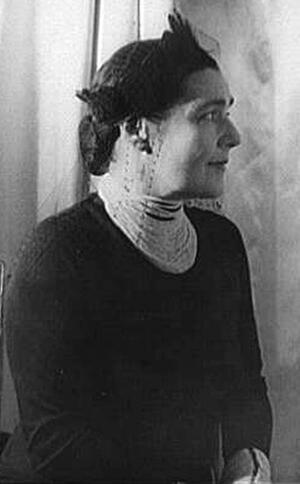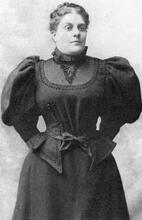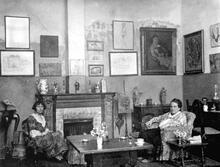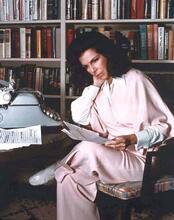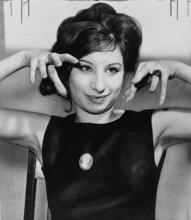Fannie Hurst
Fannie Hurst was among the most popular and sought-after writers of the post-World War I era. In her heyday, Hurst commanded huge sums from the motion picture magnates who acquired the rights to her works, 29 of which have been made into movies. Back Street (1932, 1941, 1961), Imitation of Life (1934, 1959), and Humoresque (1920, 1946) are the best known. For much of her life, Hurst was reticent about her Jewish identity; she sublimated her experience of ethnic prejudice at boarding school into a concern for African-Americans, immigrants, and working class women. Hurst’s partisan fiction was of a piece with her wider political activism. Though well intentioned, Hurst’s patronage of Zora Neale Hurston, as well as her handling of race in Imitation of Life, is now seen as a problematic legacy.
Early Life
Fannie Hurst was among the most popular and sought-after writers of the post-World War I era. In her heyday, Hurst was a contributor to the Saturday Evening Post, the Century magazine, and Cosmopolitan magazine and was featured in annual editions of The Best American Short Story. Her novels and stories were translated into a dozen languages. Hurst commanded huge sums from the motion picture magnates who acquired the rights to her works, 29 of which have been made into movies. Back Street (1932, 1941, 1961), Imitation of Life (1934, 1959), and Humoresque (1920, 1946) are among the best known. Tagged with the sobriquet “highest-priced short-story writer in America,” Hurst was rumored to have received a million dollars for Great Laughter from Metro-Goldwyn-Mayer.
Born on October 18, 1889, in Hamilton, Ohio, and raised in comfortable circumstances in St. Louis, Missouri, Fannie Hurst was the only surviving child of Rose (Koppel) Hurst and Samuel Hurst, American-born Jews of German descent. The Hursts did not practice their religion and referred their daughter to the library when she inquired about her heritage. However, the Hursts were not entirely without what was then called “race consciousness.” They complained of prejudice, knew a little Yiddish, and enjoyed traditional foods. Hurst’s father deplored the absence of Jews in their community and threatened, over the objections of his wife, to send Fannie to temple and Sunday school. Yet when Hurst’s younger sister, Edna, died of diphtheria at three years of age, it was her father who counseled Hurst to say the (Christian) Lord’s Prayer before going to bed. Distraught over Edna’s death, Rose and Samuel Hurst indulged Fannie in countless ways, providing piano and dancing lessons, extravagant clothing, a brief stint at private school, and eventually a college education at Washington University. It was in early youth that Fannie acquired her taste for flamboyant dress, which she used to assert her individuality as a counterweight to Jewish difference in later life (Braun 196).
Hurst’s mother frequently came into conflict with her husband, formerly a salesman from Memphis, Tennessee, who had risen to the position of president of a shoe manufacturing concern. Her derisive comments about her husband’s “leather bellies” (that is, cheap shoes) and parsimony often ended in humiliating public invectives against him. Rose Hurst was fiercely sensitive to slights and patronage from her husband’s rich relatives, whom she virtually barred from contact with Fannie. Consequently, Fannie Hurst was shut out of an exclusive literary club, the Pioneers, which would have afforded her highbrow Jewish contacts. Her mother preferred her own interfaith kaffeeklatsch where she was the reigning luminary, with her brilliant sense of humor. Rose complained volubly about her daughter’s solitary scribbling, which deprived her of help with the housework. But she wanted Fannie to have the best of everything and endowed her with a sense of self-worth and entitlement. Hurst claims to have ardently loved her gay and temperamental mother, only hinting at resentments.
Although she was less attached to her elegant and remote father, whose watchword was “knowledge is power,” Hurst derived a glimmering of refinement and culture from him. When Hurst’s first published story, “Ain’t Life Wonderful,” appeared in Reedy’s Mirror in 1908, she was a junior in college. Her father was ecstatic, but her mother was concerned that a brilliant daughter might prove unmarriageable. Fannie cut her own path through life, independent of her partents’ values. When Fannie fell in love with the Russian émigré pianist Jacques Danielson, whom she married in May 1915, she predicted that her parents would disapprove. She kept the marriage a secret for five years; to the Hursts, all Eastern European Jews were “kikes” (Anatomy 90). Far from settling into conventional domesticity, Hurst and Danielson retained separate residences, an arrangement that became known as the “Fannie Hurst marriage.” The Hurst-Danielson’s childless marriage ended with his death in 1952.
Work and Faith
In 1909, following graduation, Hurst secured a job in a shoe factory. Once in New York City, she worked as a restaurant server, salesperson, and actor. In her spare time, she combed the city and Ellis Island picking up local color. Hurst’s interest in the poor, sparked by a downturn in her family’s fortunes that occasioned a move from reputable Cates Avenue to a boardinghouse, emerged as a leading theme in her early writings. Hurst sublimated the ethnic and class tensions of her home environment into a concern for African-Americans, immigrants, and working people in general.
When she dealt with Jewish subjects directly, such as the violin prodigy Paul Boray of “Humoresque” (1919), Hurst concentrated on the trials of the upwardly mobile saddled with the baggage of traditional values. In Lummox (1923), the reader’s sympathies are with old lady Wallenstein, who keeps Term used for ritually untainted food according to the laws of Kashrut (Jewish dietary laws).kosher in spite of her daughter-in-law, a “blonde shixsa” who calls her own husband a “Sheenie!” Yet the novel’s hero, a Scandinavian-Slav maid-of-all-work, considers religious identification an obstacle to peace and tolerance. In contrast to old lady Wallenstein’s bond with the Jews of the Lower East Side, Bertha declares, “Those are my people. Out there. All. Everywhere” (Lummox 96, 107). Fannie wrote about Jews, but refrained from owning her Jewish identity. In her autobiography Anatomy of Me (1958), Hurst explained her reticence. She was embarrassed by the foreignness of coreligionists and mortified by the conspicuous and tasteless consumption of wealthy Jews (350). It took the rise of Hitler to force her to acknowledge anti-Semitism; in the 1940s, she was active in raising funds for refugees from Nazi Germany. In the 1950s, with the creation of the State of Israel, she developed and testified to a sense of Jewishness.
After 1912, when Hurst placed a story in the Saturday Evening Post, she never again knew a dry spell. She was a prolific author: seventeen novels, five plays, non-fiction articles, an autobiography, and an autobiographical memoir. Yet, Fannie Hurst sensed that mass appeal somehow precluded artistic greatness—“If I did not write ‘down’, I was myself down” (Anatomy 247). Hurst’s fans continue to enjoy her purple prose and sentimentality. Best loved for the tearjerker Back Street (1931), Hurst favored her most self-consciously social novel, Lummox, which earned the praise of Vladimir Ilyich Lenin and Leon Trotsky. In fact, Trotsky entertained her with an impromptu recitation of the chapter “The Cathedral Under the Sea” when she visited him in the Soviet Union. As Lummox attests, Hurst was an early chronicler of the struggles of working women, from domestic laborers to clerks to sex workers, and she contributed time and energy to New Deal programs organized on their behalf (Koppelman 516).
Success and Controversy
A prominent member of the Urban League, an organization founded in 1911 for the purpose of combatting racial discrimination in housing and employment, Hurst was friendly with leading figures of the Harlem Renaissance, such as Langston Hughes and Zora Neale Hurston, whom she met in 1925. Hurston, who served as Hurst’s chauffeur, secretary, and confidante while studying anthropology at Barnard, classed Hurst with the “Negrotarians,” a mildly derisive term for whites dedicated to Negro uplift (Lewis 98). Hurston’s “Pet Negro System” (1943) catalogued the mutually beneficial nature of patronage ties that transcend race, but Hurston acknowledged the condescension and prejudice of the white patron class. Hurston devoted a chapter of her autobiography Dust Tracks on the Road to what she styled Hurst’s “impishness” and love of fashion, a benign characterization. However, she could not have liked Hurst’s penchant for dressing her up as an Asian princess and parading her around deluxe resorts, where she would have paid a higher penalty if discovered than her patron.
Though Hurst should be commended for her eagerness to combat injustice through a popular medium, her work often reinforced ethnic stereotypes. Imitation of Life sparked controversy especially after it was filmed. The novel portrays the unlikely friendship, across racial lines, between single mothers, wherein the white woman builds a restaurant empire founded on the black woman’s southern recipes. Writing in Opportunity magazine in 1935, Sterling Brown pilloried the novel’s depiction of the loving mammy and tragic mulatto, the light-skinned daughter who rejects her mother’s accommodationist lifestyle. Significantly, the review was published in the Urban League’s literary organ. Indignant over Brown’s review “Once a Pancake,” Hurst wrote to Opportunity to protest Brown’s carping and “unintelligent” criticisms of her story, which “practically inaugurates” the film industry’s consideration of “the Negro as part of the social pattern of American life” (Caputi 701). In contrast, Hurston and Hughes, beneficiaries of Hurst’s financial largesse, praised Imitation of Life during the media fracas. In 1938, Hughes reversed course and penned the satiric play “Limitations of Life,” which called out the implicit racism informing Hurst’s stereotypical characters.
Hurst expressed a desire to minimize markers of racial difference and their exclusionary consequences in “Ain’t Human Nature Human” (1924). Like the Harlem Renaissance writers Jean Toomer (who was influenced by the mystic George Gurdijieff’s teachings and looked for a transcendence of racial categories in the new American race), George Schuyler (who also declared a post-racial identity), and Hurston (who minimized the impact of Jim Crow in her folksy narratives), Hurst was compelled by ideals of universalism and cultural commonality new to her era. She was a hardworking idealist. She played an active role in New Deal politics. She was perplexed by the cynicism of the more glamorous writers of the fabulous twenties and was confident that people would go on saving to put their children through college and striving to better themselves. As chair of the National Housing Commission (1936–1937) and Committee on Workman’s Compensation (1940), among many related activities, Hurst labored so that others might share in the American dream, of which her own success was exemplary.
Fannie Hurst died on February 23, 1968, in New York City.
For a complete bibliography of Hurst’s work, except for Fool Be Still (1964), and for her various activities, see Who’s Who of American Women (1969). Few of Hurst’s books have remained in print; in 2004, however, 30 of the short stories she wrote between 1912 and 1935 were published by the City University of New York’s Feminist Press as the collection The Stories of Fannie Hurst, edited by Susan Koppelman (Helen Rose Scheuer Jewish Women’s Series. New York: 2004), as was a new edition of Imitation of Life, edited by Daniel Itzkovitz (North Carolina: 2004).
Abbott, Traci B. “Every Woman’s Share: Female Sexuality in Fannie Hurst’s Imitation of Life. Woman’s Studies 37.6 (July 2008): 634-660.
AJYB 24:157, 70:521.
Batker, Carol. “Literary Reformers: Crossing Class and Ethnic Boundaries in Jewish Women’s Fiction of the 1920s.” Melus 25.1 (Spring 2000): 81-104.
Braun, Sarah Alisa. Jews, Writing and the Dynamics of Literary Affiliation, 1880-1940. PhD diss. University of Michigan, 2007.
Burke, Virginia M. “Zora Neale Hurston and Fannie Hurst as They Saw Each Other.” CLA Journal 20.4 (June 1977): 435-447.
Caputi, Jane. “ ‘Specifying’ Fannie Hurst: Langston Hughes’s ‘Limitations of Life’, Zora Neale Hurston’s Their Eyes Were Watching God, and Toni Morrison’s The Bluest Eye as ‘Answers’ to Hursts’s Imitation of Life.” Black American Literature Forum 24.4 (Winter 1990): 697-716.
DAB 8.
Douglas, Ann. Terrible Honesty: Mongrel Manhattan in the 1920s (1995).
EJ.
Flitterman-Lewis, Sandy. “Imitation(s) of Life: The Black Woman’s Double Determination as Troubling ‘Other.’” Literature and Psychology 34 (1988): 44–57.
Harrison-Kahan, Lori. The White Negress: Literature, Minstrelsy, and the Black-Jewish Imaginary (2011)
Hurston, Zora Neale. “The ‘Pet Negro’ System.” The American Mercury (May 1943): 593-600
Hurston, Zora Neale. “Two Women in Particular.” Dust Tracks on a Road: An Autobiography (1984).
Jay, Gregory S. White Writers, Race Matters: Fictions of Racial Liberalism from Stowe to Stockett (2017)
Kaplan, Cora. Miss Anne in Harlem: The White Women of the Black Renaissance (2014).
Koppelman, Susan. “The Educations of Fannie Hurst.” Women’s Studies International Forum 10 (1987): 503–516.
Kroeger, Brooke. Fannie: The Talent for Success of Writer Fannie Hurst (1999).
Lewis, David Levering. When Harlem Was in Vogue (1989).
Lichtenstein, Diane. “Fannie Hurst and Her Nineteenth-Century Predecessors.” Studies in American Jewish Literature 7.1 (Spring 1988): 26-39.
NAW modern.
Obituaries. NYTimes, February 24, 1968, 1:3, and St. Louis Globe Democrat, February 25, 1968.
Uffen, Ellen Serlen. “Fannie Hurst.” American Women Writers. Vol. 2 (1982).
UJE.
West, Margaret Genevieve. Zora Neale Hurston’s Place in American Literary Culture: A Study of the Politics of Race and Gender. PhD diss. Florida State University, 1997.
Wilentz, Gay. “White Patron and Black Artist: The Correspondence of Fannie Hurst and Zora Neale Hurston.” Library Chronicle of the University of Texas 35 (1986): 20-43.
WWIAJ (1926, 1928, 1938).
WWWIA 4.

